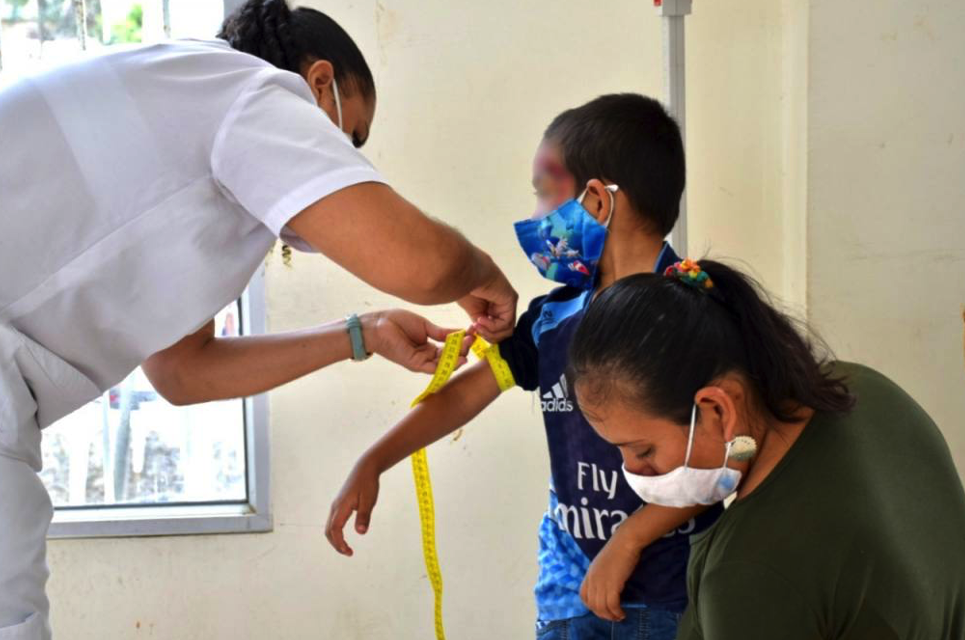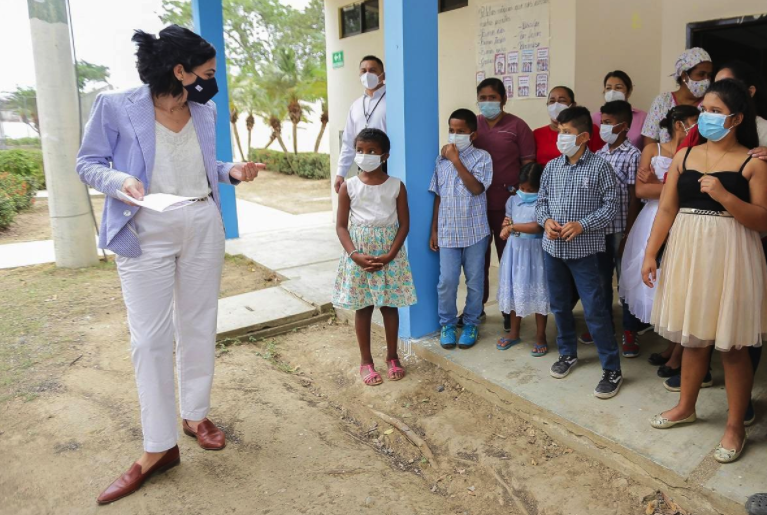Back in late August, Ecuadorian Vice President María Alejandra Muñoz, toured the Ubuntu community dining room located on Trinitaria Island, south of Guayaquil, which has delivered more than 12 thousand dishes and feeds 150 children a month.
This Ubuntu kitchen will serve as a pilot plan for the rest of the community kitchens that will be implemented at the national level.
Over the last several months, Muñoz has held meetings with international organizations, members of civil society, private companies, the Social and the Economic Cabinet, all within the framework of the Zero Hunger Circle approach, which consists of the implementation of spaces for the preparation and delivery of food in vulnerable areas previously identified by the Vice Presidency.
In addition to the soup kitchens, the approach seeks immediate intervention through decisions aimed at avoiding the waste of local agricultural production, the search for international funds to provide greater coverage for vulnerable families, and sustainable organic gardens, among others.
“Community kitchens within the Zero Hunger Circle, is an initiative that brings together the wills of all Ecuadorians whose hearts are really predisposed to serve others and to slow down the damage that COVID-19 has brought to the structure and to the social and productive fabric of Ecuador and the world, “said Muñoz.
Hunger and malnutrition hurt the most vulnerable
“In Ecuador there is hunger and chronic malnutrition and children are the most affected,” says Vice President Muñoz. Chronic child malnutrition causes growth retardation and is directly associated with deficient conditions in the mother, such as socioeconomic, nutritional and health.
After Guatemala, Ecuador—at 23%—has the highest rate of chronic malnutrition in children aged 0 to 5 in Latin America and the Caribbean, and experts say that could rise to 27% due to the ravages of COVID-19.Poor diet generates deficiency in brain development, reduction in fine and gross motor skills, and difficulty in learning.
To try to reduce these figures, Muñoz, together with international cooperation and private companies is seeking to implement an “aggressive” strategy in the six cantons with the highest rates of child malnutrition: Santa Elena, La Libertad, Guamote, Guaranda, Taisha and Arajuno. In total, Muñoz hopes that 30,646 children will benefit from the plan.
 Malnutrition condemns parts of society
Malnutrition condemns parts of society
Muñoz is making this the main objective of her short tenure as Vice President. She says that, “chronic child malnutrition is a topic that has largely been overlooked in our region, even though Ecuador registers high rates.”
She believes that this is an unsolved problem that involves governments, civil society, academia, and international cooperation and that malnutrition is the first ethical discussion that the country should have. Muñoz points out that when malnutrition limits a person’s growth, they are condemned to live in poverty and, furthermore, the cycle of poverty continues to expand.
“There is a direct relationship between poverty and chronic child malnutrition. This is a cause that unites us all and that brings us back to building ethics from the basics, from work to close social gaps,” said Muñoz.
“If we say that we have between 23% and 25% of children with chronic malnutrition, we are saying that we have a committed population in terms of progress. It is necessary to return to speak of the subjects that are fundamental for the development of the country.”
The Vice President said that a United Nations study on the impact of COVID-19 on the social fabric of the country, was also extremely worrisome.
“The first thing we find is that [regular] health care for about twelve million people just stopped, [things that] are related to prevention, nutrition, with lactating mothers or in gestation period. In the months of the highest peak in the pandemic, mothers did not come for their check-ups, and almost all first-month children did not come for their vaccinations.
The study also indicated that—in Ecuador—there is the possibility that there will be 800,000 new “extreme poor” by 2021 with food security risk.
It’s time to get aggressive
When Muñoz talks about an “aggressive plan” to reduce malnutrition, she says that it’s important to first recognize that the problem exists and that the pandemic, which is not going away anytime soon, has and will continue to, make it worse.
Along these lines, the Vice Presidency, in coordination with other health and social institutions, the Technical Secretariat of the “All Life Plan,” and international cooperation, designed an urgent intervention in six cantons of five provinces (Morona Santiago, Pastaza, Santa Elena, Chimborazo and Bolívar) across the country.
In these areas, malnutrition rates are above the national average. For example, Santa Elena has a malnutrition rate of 37%.
Muñoz says they started their efforts in these cantons with a two-prong approach. The first effort was to help mothers and with the issues of prenatal care, feeding, counseling and even pregnancy controls.
The second effort focused on the children, meaning they get initial vaccines and that mothers are provided information on how and what to feed them, including the benefits of breastfeeding. The goal is to guarantee, with the help of international cooperation, that children in poverty and extreme poverty have food.
She adds that they are implementing a model of “intersectoral articulation” at the national level and in the territories, with the Decentralized Autonomous Governments, to carry out joint actions that promote the eradication of chronic childhood malnutrition. The effort is being built upon a successful strategy implemented in Peru, in Huancavelica.
Furthermore, they are implementing community kitchens—like the one in Ubuntu—in higher risk areas, with the support of civil society, private companies and an endorsement by the United Nations.
The group is also coordinating with private companies to take care of groups of 15 children and to guarantee their food and nutrition for three years, with assistance from the United Nations and the Food Bank.
Work begins with not much time left to do a lot
The Vice President recognizes that there is a lot to do with only 8 months left in her term. But she says that they already have the support of international cooperation and they’ve already set up in Chimborazo, Bolívar and Santa Elena.
Santa Elena and La Libertad on the Coast; Arajuno and Taisha in the Amazon; Guaranda and Guamote in the Sierra, are the six cantons with the highest rates of chronic child malnutrition in Ecuador, exceeding 37%. These cantons have 127,000 families and 34,000 children under 5 years of age.
Two weeks ago, Vice President Muñoz announced that work had begun in the San Pedro commune of the Santa Elena canton and the San Raymundo neighborhood of La Libertad, where boys and girls received medical check-ups for diagnosis and monitoring of malnutrition problems; weight and height control, vaccination and Hemoglobin tests to detect anemia in children 0 to 5 years old. In addition, they provided nutritional counseling and vitamin supplements and immunization.
There is now a High-Level Management Center that has begun measuring the levels of chronic child malnutrition (DCI) and calculating the monthly nutrition demand per mother and child. The indicators will be monitored and measured monthly.
After 24 weeks, an impact evaluation will be carried out to determine the degree of efficiency and reduction of the DCI index, from the intervention in these six cantons.
Before May of next year, Muñoz says they should have the baseline and follow-up measurements to know if they are on the right track. She adds, that “it is important that the [next] government that comes, keeps the fight against chronic child malnutrition as a goal.”


0 Comments